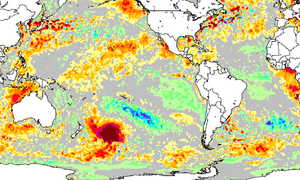Area of water in the Pacific Ocean off NZ is 6C hotter than normal, possibly due to a lack of wind in the region
A spike in water temperature of up to 6C above average across a massive patch of ocean east of New Zealand is likely to have been caused by an “anti-cyclone” weather system, a leading scientist says.
Appearing on heat maps as a deep red blob, the patch spans at least a million square kilometres – an area nearly 1.5 times the size of Texas, or four times larger than New Zealand – in the Pacific Ocean.
James Renwick, the head of geography, environment and earth sciences at Victoria University in Wellington, said the scale of the temperature spike near the sparsely populated Chatham Islands archipelago was remarkable, and had been building for weeks.
“It’s the biggest patch of above average warming on the planet right now. Normally the temperatures there are about 15C, at the moment they are about 20C,” he said.
Renwick said the blob could be linked to rising atmospheric
greenhouse gas emissions, as a result of climate change, but he expected
it was overwhelmingly due to natural variability – a strong high
pressure system and a lack of wind.Appearing on heat maps as a deep red blob, the patch spans at least a million square kilometres – an area nearly 1.5 times the size of Texas, or four times larger than New Zealand – in the Pacific Ocean.
James Renwick, the head of geography, environment and earth sciences at Victoria University in Wellington, said the scale of the temperature spike near the sparsely populated Chatham Islands archipelago was remarkable, and had been building for weeks.
“It’s the biggest patch of above average warming on the planet right now. Normally the temperatures there are about 15C, at the moment they are about 20C,” he said.
“It’s probably a very thin layer of ocean that has warmed up and there hasn’t been any wind to cool it for several weeks.”
Anti-cyclones form when a mass of air cools, contracts and becomes more dense, increasing the weight of the atmosphere and the surface air pressure.
Renwick said a surge in ocean heat over a short period could be difficult for local marine life if it penetrated far beyond the surface. Ocean temperatures are less prone to sharp changes than those on land due to the amount of energy required to warm an area of water.
He said scientists would study the spike in coming weeks to gain more insight into its cause and local impact. It followed a marine heatwave two summers ago that propelled New Zealand’s hottest summer on record, more than 3C above average, and led to tropical fish from Australia being found along the country’s coast.
Across the globe, the World Meteorological Organisation says the last decade has almost certainly been the hottest on record for land and oceans. Seas have also grown more acidic as they have absorbed carbon dioxide from the atmosphere.
Temperatures for the years 2010 to 2019 were about 1.1C above the average for the pre-industrial period. The preliminary findings of the WMO’s annual state of the global climate report released earlier this month found this year was likely to be the second or third warmest since records began.

No comments:
Post a Comment